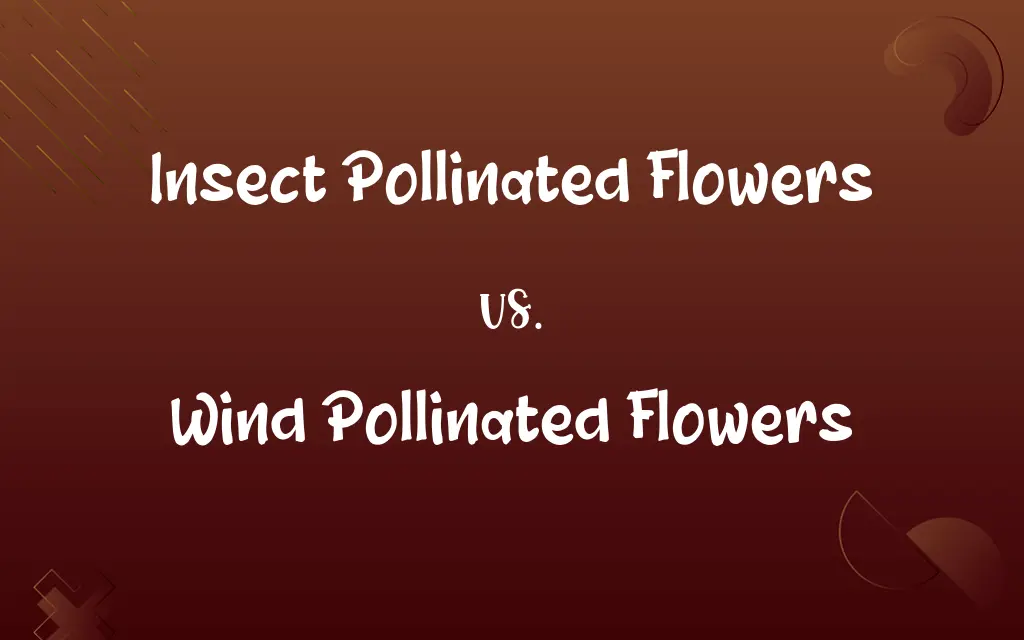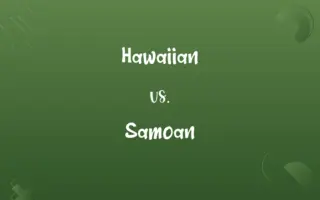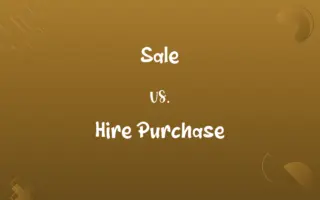Insect Pollinated Flowers vs. Wind Pollinated Flowers: Know the Difference

By Shumaila Saeed || Published on January 31, 2024
Insect Pollinated Flowers attract insects with bright colors and scent for pollination, while Wind Pollinated Flowers rely on wind to disperse pollen, often having small, inconspicuous flowers.

Key Differences
Insect Pollinated Flowers are typically vibrant and fragrant, designed to attract insects. These flowers often produce nectar as a reward for pollinators. Wind Pollinated Flowers, in contrast, are usually duller in color, with no scent or nectar, as they do not need to attract insects.
Shumaila Saeed
Jan 31, 2024
Wind Pollinated Flowers have light, dry pollen that can be easily carried by the wind. This pollen is often produced in large quantities to increase the chance of successful pollination. Insect Pollinated Flowers have stickier or spikier pollen, which clings to the bodies of insects when they visit the flower.
Shumaila Saeed
Jan 31, 2024
Insect Pollinated Flowers often have structures that facilitate the transfer of pollen onto visiting insects, such as sticky stigmas or specialized petal formations. Wind Pollinated Flowers lack these intricate structures, as their pollination strategy does not rely on animal interaction.
Shumaila Saeed
Jan 31, 2024
The reproductive organs of Insect Pollinated Flowers are typically enclosed or protected to prevent pollen from being wasted. In contrast, Wind Pollinated Flowers have exposed stamens and stigmas to maximize pollen dispersal and reception by the wind.
Shumaila Saeed
Jan 31, 2024
In terms of ecological impact, Insect Pollinated Flowers support a wide range of insect species, contributing to biodiversity. Wind Pollinated Flowers, while less supportive of insect life, are often more efficient in pollen dispersal over large areas.
Shumaila Saeed
Jan 31, 2024
ADVERTISEMENT
Comparison Chart
Pollination Strategy
Attract insects for pollination
Rely on wind for pollen dispersal
Shumaila Saeed
Jan 31, 2024
Floral Structures
Specialized structures for insect interaction
Lack intricate structures for animal interaction
Shumaila Saeed
Jan 31, 2024
Ecological Impact
Support biodiversity and insect life
Efficient in dispersing pollen over large areas
Shumaila Saeed
Jan 31, 2024
ADVERTISEMENT
Insect Pollinated Flowers and Wind Pollinated Flowers Definitions
Insect Pollinated Flowers
Plants where pollen is transferred primarily by insect activity.
Insect pollinated flowers in the orchard ensured a good crop through effective pollination.
Shumaila Saeed
Jan 11, 2024
Wind Pollinated Flowers
Plants with light, airborne pollen adapted for wind dispersal.
Wind pollinated flowers lined the hillside, their pollen carried far by the strong winds.
Shumaila Saeed
Jan 11, 2024
Insect Pollinated Flowers
Flowers that rely on insects for transferring pollen.
The bee buzzed from one insect pollinated flower to another, collecting nectar.
Shumaila Saeed
Jan 11, 2024
Wind Pollinated Flowers
Plants where flowers are structured to maximize wind exposure for pollen dispersal.
The wind pollinated flowers had long stamens that protruded to catch the wind.
Shumaila Saeed
Jan 11, 2024
Insect Pollinated Flowers
Flowers that offer nectar and pollen as a reward to visiting insects.
Hummingbirds frequently visited the insect pollinated flowers for their nutritious nectar.
Shumaila Saeed
Jan 11, 2024
ADVERTISEMENT
Wind Pollinated Flowers
Flowers lacking bright colors and scents, as they do not attract insects.
The plain-looking wind pollinated flowers were easily overlooked in the garden.
Shumaila Saeed
Jan 11, 2024
Insect Pollinated Flowers
Plants that have evolved features to attract pollinators like bees and butterflies.
The garden was full of insect pollinated flowers, attracting a myriad of colorful butterflies.
Shumaila Saeed
Jan 11, 2024
Wind Pollinated Flowers
Flowers that depend on wind for the transfer of pollen.
The field of wind pollinated flowers swayed, releasing clouds of pollen into the breeze.
Shumaila Saeed
Jan 11, 2024
Insect Pollinated Flowers
Flowers characterized by bright colors and sweet scents to lure insects.
The fragrant aroma of insect pollinated flowers filled the air in the spring meadow.
Shumaila Saeed
Jan 11, 2024
Wind Pollinated Flowers
Species that produce large quantities of pollen to ensure successful wind pollination.
During spring, the wind pollinated flowers produced so much pollen that it dusted everything nearby.
Shumaila Saeed
Jan 11, 2024
Repeatedly Asked Queries
What attracts insects to Insect Pollinated Flowers?
Bright colors, sweet scents, and nectar.
Shumaila Saeed
Jan 31, 2024
Are Insect Pollinated Flowers important for the ecosystem?
Yes, they support biodiversity and insect populations.
Shumaila Saeed
Jan 31, 2024
Do Insect Pollinated Flowers always produce nectar?
Mostly, as nectar is a key attractant for insects.
Shumaila Saeed
Jan 31, 2024
Can Wind Pollinated Flowers cause allergies?
Yes, their airborne pollen is a common allergen.
Shumaila Saeed
Jan 31, 2024
How do bees help Insect Pollinated Flowers?
By transferring pollen between flowers while collecting nectar.
Shumaila Saeed
Jan 31, 2024
What role do butterflies play in pollinating Insect Pollinated Flowers?
Butterflies transfer pollen as they move from flower to flower.
Shumaila Saeed
Jan 31, 2024
How do Wind Pollinated Flowers disperse their pollen?
Through the wind, using light and dry pollen.
Shumaila Saeed
Jan 31, 2024
Are Wind Pollinated Flowers less colorful than insect-pollinated ones?
Generally, yes, as they do not need to attract insects.
Shumaila Saeed
Jan 31, 2024
Do Wind Pollinated Flowers grow in specific environments?
They are common in open, windy areas where wind dispersal is effective.
Shumaila Saeed
Jan 31, 2024
Are Wind Pollinated Flowers important for crop production?
They are essential for some crops, like many grains.
Shumaila Saeed
Jan 31, 2024
What time of year are Insect Pollinated Flowers most common?
Typically in spring and summer, coinciding with insect activity.
Shumaila Saeed
Jan 31, 2024
Do Insect Pollinated Flowers have specific shapes?
Yes, often designed to accommodate the bodies of specific pollinators.
Shumaila Saeed
Jan 31, 2024
Can Wind Pollinated Flowers cross-pollinate with insect-pollinated ones?
Rarely, as their pollination mechanisms are quite different.
Shumaila Saeed
Jan 31, 2024
Are there any hybrid plants between Insect and Wind Pollinated Flowers?
It's uncommon due to different pollination strategies.
Shumaila Saeed
Jan 31, 2024
Is pollen from Wind Pollinated Flowers more abundant than from insect-pollinated ones?
Yes, as wind pollination is less targeted, more pollen is produced.
Shumaila Saeed
Jan 31, 2024
Do hummingbirds pollinate Insect Pollinated Flowers?
Yes, they are important pollinators for many such flowers.
Shumaila Saeed
Jan 31, 2024
Are Wind Pollinated Flowers found in residential gardens?
Less commonly, as they are not as visually appealing as insect-pollinated varieties.
Shumaila Saeed
Jan 31, 2024
Can Insect Pollinated Flowers adapt to different pollinators?
Yes, they can evolve features to attract specific types of insects.
Shumaila Saeed
Jan 31, 2024
Does weather affect Wind Pollinated Flower success?
Yes, wind patterns and strength are crucial for effective pollen dispersal.
Shumaila Saeed
Jan 31, 2024
Do Insect Pollinated Flowers have a longer blooming period?
Often, to maximize the chances of insect visitation.
Shumaila Saeed
Jan 31, 2024
Share this page
Link for your blog / website
HTML
Link to share via messenger
About Author
Written by
Shumaila SaeedShumaila Saeed, an expert content creator with 6 years of experience, specializes in distilling complex topics into easily digestible comparisons, shining a light on the nuances that both inform and educate readers with clarity and accuracy.









































































